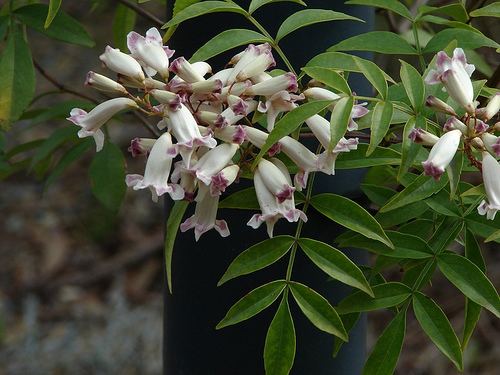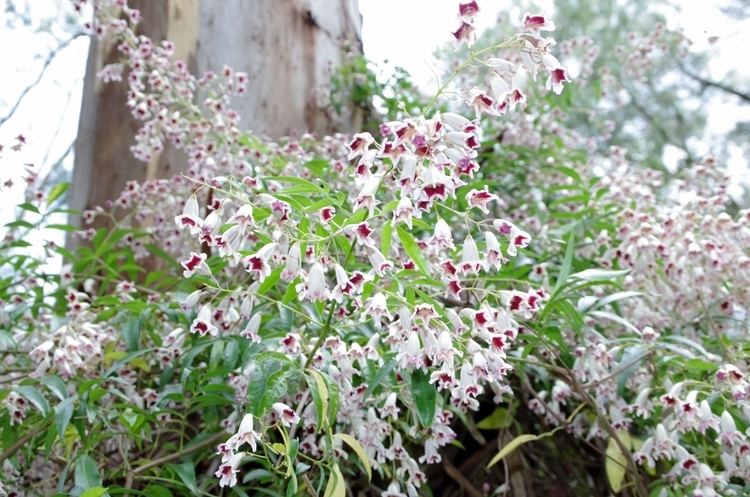Genus Pandorea Rank Species | ||
 | ||
Similar Pandorea, Pandorea jasminoides, Abutilon megapotamicum, Buddleja lindleyana, Lomandra | ||
Pandorea pandorana, commonly known as the Wonga Wonga Vine, is a species of woody climbing vine in the family Bignoniaceae. It is found in Australia, Malesia and the southwestern Pacific region. It forms large pointed pods filled with papery seeds. It is easy to germinate, having two-lobed dicotyledons. It is a popular garden plant, common cultivars include the yellow-flowered P. 'Golden Showers', the white-flowered P. 'Snowbells', and the pinkish P. 'Ruby Belle'. The wood was used as in making spears for woomeras in the Central and Western deserts.
Contents

Taxonomy

The species was first described by English botanist Henry Charles Andrews in 1800 as Bignonia pandorana, before being given its current binomial name in 1928 by Steenis. Both the generic and specific name are derived from Greek mythological figure Pandora. The Scottish botanist Robert Brown had described it as Tecoma australis but this name was ruled invalid. A form found in dryer inland regions was previously known as P. doratoxylon.
The subspecies austrocaledonica, known locally as Boat Vine, is known from New Caledonia, Vanuatu and Lord Howe Island.
Description

Pandorea pandorana ranges in habit from a scrambling plant to a vigorous vine, growing on larger trees in forested habitats. It has glossy green leaves arranged oppositely along the stem. The pinnate leaves are around 8–16 cm (3–6.5 in) long and have 3–9 leaflets of varying widths. The juvenile leaves are finer and have serrated margins, and more finely divided into 7–13 leaflets. Flowering occurs in spring. The tubular or funnel-shaped flowers are highly variable in colour, ranging from cream-white or all-white to maroon-throated, burgundy or even yellow-orange. Flowering is followed in summer by 3–8 cm (1.4–3.4 in) long and 1–2 cm (0.4–0.8 in) wide oblong-shaped seed pods, which are initially bright green before turning brown and releasing numerous papery seeds around 1-1.5 cm (0.5 in) in diameter which are released in large quantities.
Distribution and habitat

A highly variable species, it is found across continental Australia in every state. It is also found in Indonesia, Papua New Guinea, the Solomon Islands, New Caledonia and Vanuatu. It is also found on Flinders Island in Bass Strait, but not on mainland Tasmania. In New Zealand the species has become naturalised within disturbed native vegetation near parks and gardens in which it is cultivated.

It occurs in many habitats, from rainforest, to dry sclerophyll forest, to dry scrub and rocky outcrops in arid regions. It can grow in either clay or sand-based soils.
Uses

The highly flexible wood of Pandorea pandorana was the most sought-after for use in woomera-cast spears among the people of the Central and Western Deserts. Its versatility allowed short pieces to be spliced together if longer ones could not be found. Due to its cultural significance, a group of mythological women with slender and flexible bodies were named after it.
Cultivation
Pandorea pandorana was first raised in England in 1793 by Lee and Kennedy at their nursery in Hammersmith and had flowered in cultivation by 1805. Material was also sent to the garden of the Château de Malmaison under the auspices of Joséphine de Beauharnais. Its floral display makes it a popular and widely grown garden plant. It is an evergreen, half-hardy (hardy to about minus 5 °C once established), twining plant with lovely foliage, particularly so on young plants when it is very finely cut and somewhat fern-like. It is suitable for indoor or outdoor planting. Pruning is necessary to control the quick growing plant, which can overwhelm other plants in a small garden. The plant prefers full-sun to partial shade. It has been argued that the more sun it receives, the more flowers will bloom as a result. The species may be propagated by fresh seed or semi hard wood tip cuttings.
The Nursery and Garden Industry in Australia promoted P. pandorana as a native alternative to the invasive garden climber Black-eyed Susan (Thunbergia alata).
Cultivars
Several different coloured varieties have become available in Australia and the United States.
